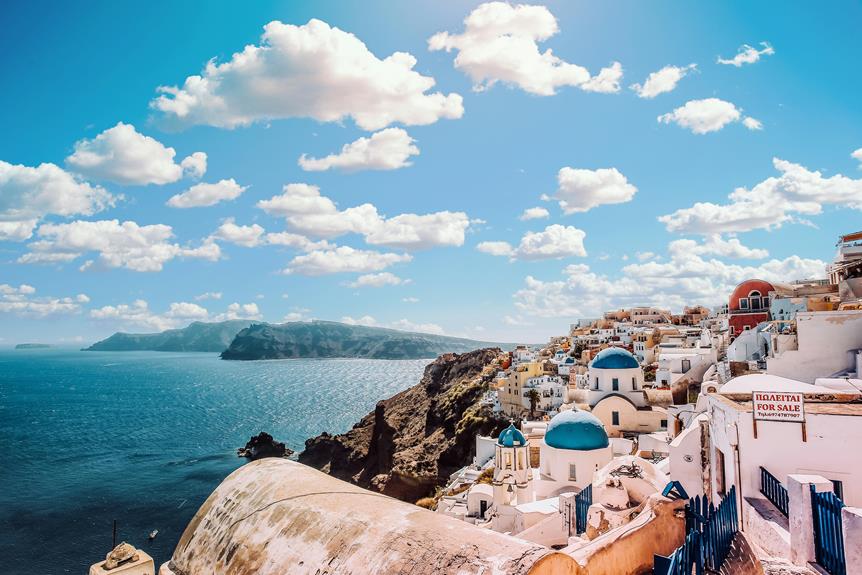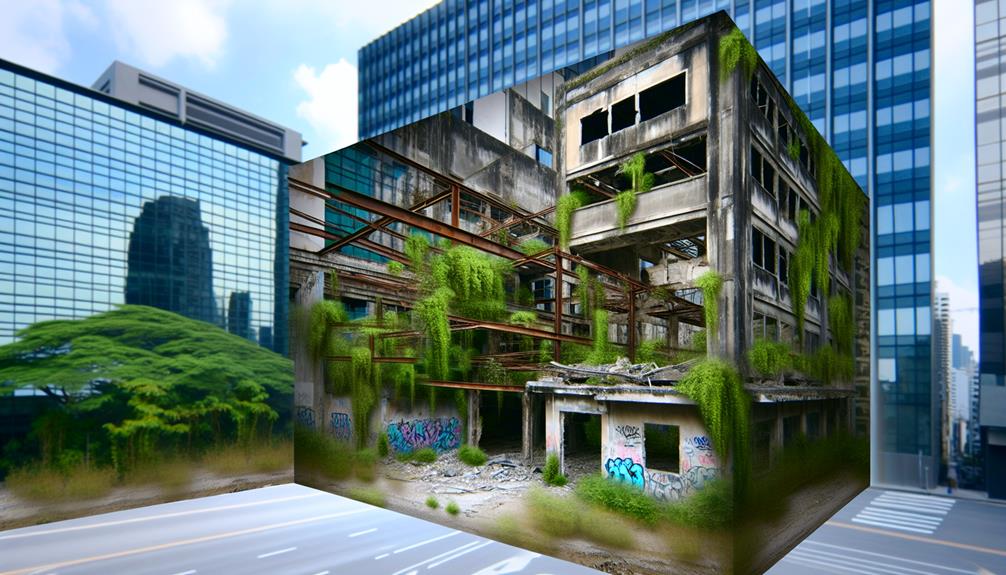In the Mediterranean island of Cyprus lies a city frozen in time, a place where echoes of past prosperity now mingle with the eerie stillness of abandonment. Varosha's story is one of contrasts, where the bustling resort town of the 1970s now stands as a silent witness to unresolved conflict and geopolitical tensions. As the sun sets over this forbidden zone, questions arise about its fate, the potential it holds, and the complexities surrounding its past and potential future. What lies ahead for Varosha remains a subject of intrigue and debate, stirring imaginations and sparking discussions on the delicate balance between history, politics, and the human spirit.
Key Takeaways
- Varosha is a deserted city in Cyprus.
- Abandoned after the 1974 Turkish invasion.
- Varosha remains a forbidden zone today.
- Efforts for reunification ongoing.
- Future potential for economic growth and development.
The History of Varosha
During the late 20th century, Varosha, a once vibrant city located in Cyprus, experienced a tumultuous history marked by political conflict and displacement. The roots of Varosha's history can be traced back to the period of Ottoman rule over Cyprus, which lasted from 1571 to 1878. The Ottoman legacy left a lasting impact on the island, influencing its culture, society, and governance structures.
Following the decline of the Ottoman Empire, Cyprus came under British colonial rule in 1878. The British administration played a significant role in shaping the modern history of Varosha and Cyprus as a whole. Under British rule, Cyprus experienced significant social and economic changes, including the development of infrastructure and the introduction of modern institutions.
The colonial legacy left behind by the British also contributed to the ethno-political tensions that would later engulf Varosha. The division between the Greek Cypriot and Turkish Cypriot communities deepened over time, leading to conflicts and acts of violence. These tensions ultimately culminated in the partition of Cyprus in 1974, with Varosha becoming a ghost town following the Turkish invasion.
Turkish Invasion of 1974
The Turkish invasion of 1974 marked a significant turning point in the history of Varosha, Cyprus, leading to its transformation into a deserted and abandoned city. The invasion, which aimed to assert control over the island, had profound consequences for Varosha and its inhabitants. The impact of the invasion was devastating, as the once-thriving city was quickly evacuated, leaving behind empty streets and buildings.
The consequences of the Turkish invasion were far-reaching. Varosha, once a popular tourist destination known for its vibrant atmosphere, was now a ghost town, fenced off and left to decay. The residents who fled were unable to return to their homes, and the city remained frozen in time, a stark reminder of the conflict that tore families apart and left a community in ruins.
The Turkish invasion of 1974 not only physically divided Varosha but also left deep emotional scars on its people. The loss of their homes and livelihoods had a lasting impact on the residents, many of whom were forced to start anew in other parts of the island. The once-prosperous city of Varosha was forever changed by the events of 1974, becoming a symbol of the ongoing conflict and division in Cyprus.
Abandonment and Frozen in Time
Signifying a poignant snapshot frozen in the annals of history, Varosha of Cyprus stands as a haunting proof to abandonment and the relentless passage of time. Once a bustling tourist destination, Varosha now lies eerily silent and untouched, frozen in the state it was left in after the Turkish invasion of 1974. The abandoned buildings, hotels, and businesses create a haunting beauty that captivates urban explorers and historians alike.
Exploring the urban landscape in Varosha reveals a scene of desolation and decay, where nature slowly reclaims what was once a vibrant city. The streets are now overgrown with vegetation, and buildings stand as empty shells of their former glory. The eeriness of Varosha's deserted landscape combined with the backdrop of the beautiful Mediterranean Sea creates a surreal experience for those brave enough to venture into its abandoned streets.
The frozen state of Varosha serves as a time capsule, preserving the architecture and lifestyle of the 1970s. The remnants of daily life – from furniture left behind in homes to faded signs on storefronts – offer a glimpse into a past abruptly halted by conflict. Despite the passage of time, Varosha's aura of abandonment remains a poignant reminder of the consequences of war and the fragility of human civilization.
Varosha Today: A Forbidden Zone
Varosha today stands as a restricted area, off-limits to visitors and frozen in a time capsule of abandonment. Once a bustling tourist destination in Famagusta, Cyprus, Varosha now remains deserted, surrounded by barbed wire and warning signs barring entry. The forbidden zone of Varosha serves as a poignant reminder of the division and conflict that has plagued Cyprus for decades.
Despite its restricted status, Varosha has attracted interest from forbidden tourism enthusiasts and urban explorers looking to catch a glimpse of its hauntingly beautiful decay. The allure of exploring a place frozen in time, with its dilapidated buildings and empty streets, appeals to those seeking to unravel the mysteries of its past.
Forbidden tourism in Varosha, however, raises ethical and legal concerns. The area is under the control of the Turkish military, and any attempts to enter are met with strict enforcement. Trespassing into Varosha not only poses risks to personal safety but also undermines efforts for peace and reunification on the island.
As Varosha remains a forbidden zone, its future hangs in the balance, caught between political tensions and the desire for preservation. The allure of urban exploration clashes with the reality of a place scarred by conflict, making Varosha a symbol of both intrigue and tragedy in Cyprus.
Efforts for Reunification
Efforts towards reunification in Cyprus have long been a focal point in addressing the longstanding division and conflict on the island. Peace talks and diplomatic negotiations have been ongoing for decades, aiming to find a mutually acceptable solution that would bring an end to the division between the Greek Cypriot and Turkish Cypriot communities. Various initiatives, led by the United Nations and other international actors, have been instrumental in facilitating dialogue between the two sides.
One of the key milestones in the reunification efforts was the Annan Plan in 2004, which proposed a thorough settlement to the Cyprus issue. Although the plan was rejected by the Greek Cypriots in a referendum, it underscored the international community's commitment to finding a peaceful resolution to the conflict. Since then, numerous rounds of negotiations have taken place, with the aim of bridging the divide between the two communities and creating a united Cyprus.
Despite the challenges and setbacks faced in the peace process, there remains a shared desire among many Cypriots for reunification. The recent resumption of talks in 2021, under the auspices of the United Nations, signals a renewed commitment to finding a lasting solution. As efforts continue towards reunification, it is essential for all parties involved to engage in constructive dialogue and compromise in order to achieve a peaceful and sustainable resolution to the Cyprus issue.
The Future of Varosha
Amidst ongoing discussions on the reunification of Cyprus, the potential future development of Varosha remains a pivotal point of consideration in the region's geopolitical landscape. Varosha, with its strategic location and untapped potential, presents a unique opportunity for economic growth and revitalization in Cyprus. The city, once a bustling tourist destination, now stands as a ghost town, frozen in time since the conflict in 1974.
Unlocking the potential development of Varosha could bring about a range of economic opportunities for both the local population and the broader region. With its proximity to the Mediterranean Sea and its historical significance, Varosha has the potential to become a hub for tourism, trade, and investment. The development of Varosha could lead to job creation, infrastructure improvements, and increased revenue for the region.
However, the future of Varosha is intricately linked to the reunification efforts in Cyprus. Any potential development plans must consider the political sensitivities surrounding Varosha and the concerns of all relevant stakeholders. Ensuring a sustainable and inclusive development strategy for Varosha will be vital in fostering long-term stability and prosperity in the region.
Frequently Asked Questions
Is It Possible to Visit Varosha as a Tourist?
When contemplating a tourist experience, it is vital to acknowledge the historical significance of a destination. Understanding how the past has shaped a place can enrich the visitor's perspective.
Delving into the heritage and cultural value of a location can provide a more profound and meaningful experience for tourists. This interplay between historical significance and the tourist experience forms the essence of exploring a destination in a holistic manner.
What Measures Are in Place to Protect Varosha's Buildings?
Building preservation measures are essential for maintaining historical significance. Various methods like structural stabilization, regular maintenance, and conservation efforts help protect these structures from deterioration.
Adherence to strict guidelines, such as UNESCO standards or local heritage regulations, guarantees the long-term safeguarding of the buildings' integrity.
Are There Any Plans to Redevelop Varosha in the Future?
Future redevelopment plans are an essential aspect of urban revitalization efforts. While some may argue that redevelopment could lead to the loss of historical significance or cultural identity, it is important to take into account the potential benefits such as economic growth, job creation, and improved infrastructure.
How Does the Local Wildlife Thrive in Varosha's Abandoned Area?
Local ecosystems in abandoned areas like Varosha exhibit unique dynamics due to reduced human interference, allowing wildlife to adapt and thrive.
Wildlife behavior in these environments often shows signs of resilience and adaptation to the new conditions.
Species diversity may increase as nature reclaims the space, with some animals utilizing abandoned structures for shelter and nesting.
This process can lead to the establishment of new ecological niches and interactions within the local wildlife community.
Can Varosha's Former Residents Ever Return to Their Homes?
When considering the possibility of former residents returning to their homes, various factors come into play.
Property rights are vital in determining the legal ownership of the residences within a specific area.
Political implications can also heavily influence the decision-making process, affecting the feasibility and legality of residents reclaiming their properties.
These aspects intertwine to create a complex situation that requires careful consideration and potentially significant legal and political interventions to address effectively.
Conclusion
To sum up, Varosha in Cyprus stands as a stark reminder of the consequences of ethno-political tensions and conflict. Despite being off-limits to visitors, it continues to attract forbidden tourism enthusiasts and urban explorers.
Efforts for reunification and future revitalization of Varosha remain ongoing, with the potential for a new chapter in its history. For example, the case of the Green Line in Cyprus serves as a model for potential reconciliation and restoration in divided territories.


